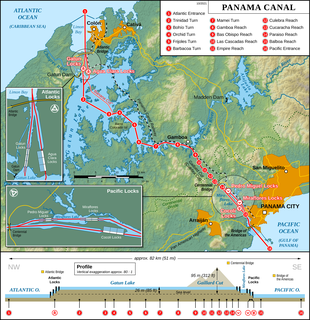
The Cleveland Browns are a professional American football team based in Cleveland. Named after original coach and co-founder Paul Brown, they compete in the National Football League (NFL) as a member club of the American Football Conference (AFC) North division. The Browns play their home games at FirstEnergy Stadium, which opened in 1999, with administrative offices and training facilities in Berea, Ohio. The Browns' official club colors are brown, orange, and white. They are unique among the 32 member franchises of the NFL in that they do not have a logo on their helmets.

The Panama Canal is an artificial 82 km (51 mi) waterway in Panama that connects the Atlantic Ocean with the Pacific Ocean and divides North and South America. The canal cuts across the Isthmus of Panama and is a conduit for maritime trade. One of the largest and most difficult engineering projects ever undertaken, the Panama Canal shortcut greatly reduces the time for ships to travel between the Atlantic and Pacific oceans, enabling them to avoid the lengthy, hazardous Cape Horn route around the southernmost tip of South America via the Drake Passage or Strait of Magellan and the even less popular route through the Arctic Archipelago and the Bering Strait.

The bright-line brown-eye is a moth of the family Noctuidae. The species was first described by Carl Linnaeus in his 1758 10th edition of Systema Naturae. It is a common species throughout Europe, but is also found in North Africa, temperate North Asia and Central Asia, Asia Minor, Syria, and Turkestan, northern India, China, Korea and Japan.

Eupsilia transversa, the satellite, is a moth of the family Noctuidae. The species was first described by Johann Siegfried Hufnagel in 1766. It is distributed throughout the Palearctic.

Craugastor fitzingeri is a species of frog in the family Craugastoridae. It is found in northwestern Colombia, Panama, Costa Rica, eastern Nicaragua, and northeastern Honduras. The specific name fitzingeri honors Leopold Fitzinger, an Austrian zoologist. Common name Fitzinger's robber frog has been coined for this species.
Craugastor podiciferus, also known as the Rio Changena robber frog, is a species of frog in the family Craugastoridae. It is found in Costa Rica and Panama. Its natural habitat is subtropical or tropical moist montane forests. It is threatened by habitat loss.

The russet-crowned quail-dove is a species of bird in the family Columbidae. It is found in Panama and far northwestern Colombia.

The purplish-backed quail-dove is a species of bird in the family Columbidae. It is found in Costa Rica and Panama.

The red-headed barbet is a species of bird in the family Capitonidae, the New World barbets. It is found in Costa Rica, Panama, Venezuela, Colombia, Ecuador and Peru.

The orange-bellied trogon is a subspecies of the collared trogon in the family Trogonidae. It is now usually considered as a morph of the collared trogon, but was previously sometimes treated as a separate species. It is found in the Talamancan montane forests of Costa Rica and Panama.

The red-tailed squirrel is a species of tree squirrel distributed from southern Central America to northern South America.

Tiliacea citrago, the orange sallow, is a species of moth of the family Noctuidae. It is found in Europe as far east as the Caucasus Mountains and the Urals.

Cephalopholis panamensis, the Pacific graysby or Panama graysby, is a species of marine ray-finned fish, a grouper from the subfamily Epinephelinae which is in the family Serranidae which also includes the anthias and sea basses. It is found in the Eastern Pacific Ocean.

The frosted orange moth is a moth of the family Noctuidae which is found in Europe, Armenia, Syria and east through the Palearctic to western Siberia. It has also been recorded in Algeria. The species was first described by Michael Denis and Ignaz Schiffermüller in 1775. The frosted orange is a night-flying species with orange and brown speckled wings allow for perfect camouflage against autumn leaves in the daytime. It is attracted to light and does not come to flowers, and its larva inhabit the stems and roots of the species' food plants.

Xylophanes libya, the Libya sphinx, is a moth of the family Sphingidae. The species was first described by Herbert Druce in 1878. It is known from southern Texas, Mexico, Belize, Guatemala, Panama and from Venezuela south and west to Bolivia and Paraguay.

Phoebis argante, the apricot sulphur or Argante giant sulphur, is a butterfly in the family Pieridae.

Heliconius ethilla, the ethilia longwing, is a butterfly of the family Nymphalidae. It was described by Jean-Baptiste Godart in 1819. It is found from Panama to southern Brazil. The habitat consists of marginal forests.
Pilocrocis runatalis is a moth in the family Crambidae. It was described by Harrison Gray Dyar Jr. in 1914. It is found in Panama.
Helcystogramma perceptella is a moth in the family Gelechiidae. It was described by August Busck in 1914. It is found in Panama.
Rhindoma rosapicella is a moth in the family Depressariidae, and the only species in the genus Rhindoma. It was described by August Busck in 1914 and is found in Panama.















